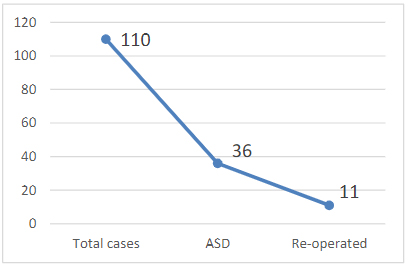The Prevalence of Adjacent Segment Disease and Reoperation Following Transpedicular Screw Fixation of Lumbar Spine
DOI:
https://doi.org/10.21271/ZJPAS.35.3.23Keywords:
Adjacent; Segment disease; Reoperation; Lumbar spine; Spinal fixationAbstract
Background: Adjacent segment disease is a condition in which the mobile level next to the fused section degenerates as a result of increased biomechanical stress and mobility, it may be rostral, caudal, or both rostral and caudal to fused segment.
Patients and Methods: A retrospective study was conducted on 110 patients who underwent transpedicular screw fixation of the lumbar spine between January 2011 and May 2019. Demographic data of the patients, including patient’s age, gender, symptoms, type of fixation, the extent of fixation, segments fixed, date and pathology causing first and second surgery, were taken from patients attending the outpatient department of Hawler Teaching Hospital on Mondays and Wednesdays from October 2018 to May 2021.
Results: Thirty-six (32.72%) patients of 110 patients who were included in the study developed ASD. Eleven (10%) patients needed a second surgery for ASD.
Conclusions: The rate of developing ASD was (32.72%) out of 110 patients who were included in our study and had transpedicular screw fixation. The rate of patients that needed a second surgery for ASD was (10%). Male gender, advanced age, floating fixation and multiple level fixation were variables that contributed to a higher rate of developing ASD. Multiple level fixation was the only variable with clinical significance. These rates in our study were comparable with the literature's stated prevalence of ASD after spinal fixation and reoperation for ASD.
References
Adogwa O, Parker SL, Shau DN, Mendenhall SK, Aaronson OS, Cheng JS, Devin CJ, McGirt MJ. Preoperative Zung Depression Scale predicts outcome after revision lumbar surgery for adjacent segment disease, recurrent stenosis, and pseudarthrosis. The Spine Journal. 2012 Mar 1;12(3):179-85.
Aiki H, Ohwada O, Kobayashi H, Hayakawa M, Kawaguchi S, Takebayashi T, Yamashita T. Adjacent segment stenosis after lumbar fusion requiring second operation. Journal of Orthopaedic Science. 2005 Sep;10(5):490-5.
Kersten, R. F. M. R., et al. "Lumbar spinal fusion: indications, surgical techniques and post-operative management." A survey among spine surgeons in the Netherlands. MOJ Orthop Rheumatol 4.6 (2016).
Lawrence BD, Wang J, Arnold PM, Hermsmeyer J, Norvell DC, Brodke DS. Predicting the risk of adjacent segment pathology after lumbar fusion: a systematic review. Spine. 2012 Oct 15;37:S123-32.
Lee JC, Kim Y, Soh JW, Shin BJ. Risk factors of adjacent segment disease requiring surgery after lumbar spinal fusion: comparison of posterior lumbar interbody fusion and posterolateral fusion. Spine. 2014 Mar 1;39(5):E339-45.
Li XF, Lv ZD, Yin HL, Song XX. Impact of adjacent pre-existing disc degeneration status on its biomechanics after single-level anterior cervical interbody fusion. Computer Methods and Programs in Biomedicine. 2021 Sep 1;209:106355.
Masevnin S, Ptashnikov D, Michaylov D, Meng H, Smekalenkov O, Zaborovskii N. Risk factors for adjacent segment disease development after lumbar fusion. Asian Spine Journal. 2015 Apr;9(2):239.
McGirt M, Adogwa O, Parker S, Shau D, Mendenhall S, Aaronson O, Cheng J, Devin CJ. Preoperative Zung Depression Scale Predicts Outcome After Revision Lumbar Surgery for Adjacent Segment Disease, Recurrent Stenosis and Pseudoarthrosis. The Spine Journal. 2011 Oct 1;11(10):S110-1.
Nayar G, Roy S, Lutfi W, Agarwal N, Alan N, Ozpinar A, Hamilton DK, Okonkwo DO, Kanter AS. Incidence of adjacent-segment surgery following stand-alone lateral lumbar interbody fusion. Journal of Neurosurgery: Spine. 2021 Jun 18;35(3):270-4.
Orhurhu VJ, Chu R, Gill J. Failed Back Surgery Syndrome. StatPearls. Treasure Island (FL). StatPearls Publishing. Retrieved September. 2020;7:2020.
Scemama C, Magrino B, Gillet P, Guigui P. Risk of adjacent-segment disease requiring surgery after short lumbar fusion: results of the French Spine Surgery Society Series. Journal of Neurosurgery: Spine. 2016 Jul 1;25(1):46-51.
Wang H, Ma L, Yang D, Wang T, Liu S, Yang S, Ding W. Incidence and risk factors of adjacent segment disease following posterior decompression and instrumented fusion for degenerative lumbar disorders. Medicine. 2017 Feb;96(5).

Downloads
Published
How to Cite
Issue
Section
License
Copyright (c) 2023 Shallaw Mahdi Saleem, Hoshang Sdeeq Rashid , Anjam Ibrahim Rowandizy

This work is licensed under a Creative Commons Attribution 4.0 International License.













